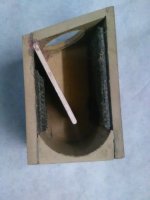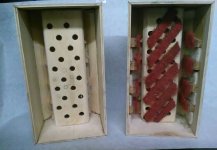I've done all-sorts to stop the rear reflection, the pic on the left is the most simple, the two other pictures are of a "Christmas tree" diffuser. When I started fiddling with speakers, I use a steel mass to isolate the vibrations from the driver from the rest of the cabinet, and it was remarkable how this highlighted the echo's from inside. My favourite speaker that I've made is a "box in a box" design, both the mid/bass and cone tweeter are in their own enclosures, inside and mechanically isolated from the main enclosure, the mi/bass enclosure is so short front to back that a wave/reflection can't form within it's frequency range.I've always wondered about this, everyone is so engross in building a dead cabinets but I don't think I've read any thread on
preventing sound within the cabinet from reflecting onto the back of speaker cone. Isn't this far more important ?
Attachments
Yes you can make something like a lossy "black hole".I've always wondered about this, everyone is so engross in building a dead cabinets but I don't think I've read any thread on
preventing sound within the cabinet from reflecting onto the back of speaker cone. Isn't this far more important ?
See my post:
https://www.diyaudio.com/community/threads/cabinet-material-measurement.392930/post-7199189
or leak it out and harness it to do some work instead of trying to contain it. like OB or passive cardioid.
edit. Well, would need another system for bass though, perhaps not proper advice on fullrange forum
edit. Well, would need another system for bass though, perhaps not proper advice on fullrange forum
Me, I'd rigid couple by the magnet, with the support structure loaded to the back & top (3) corners. For the front driver frame I'd be trying to minimise the coupling i.e. no contact, but also need to maintain an acoustic seal with the front baffle. To do that, I'd probably have the front baffle made up as two sections upper/lower; the lower section glued on for stiffness, and the upper section for the driver being bolted on to allow access to the clamp & rear panel mounted driver. I'd also make this top baffle section from 3 -10mm aluminium. The baffle driver hole would be ~1mm bigger than the outer driver dimensions so no contact no fixing. How I'd seal the gap with minimal coupling would depend on the driver frame thickness and shape, but i'd aim to create a sandwich of wool between two layers of alumimum. I would also aim to have the driver flush with the front layer. The rear aluminium layer be rigid mounted from behind the driver frame, not too big perhaps 25mm bigger than driver dimensions. If the driver frame is thin then a shim may be needed to accommodate the thickness of the wool layer sanwiched between to two alu layers.


